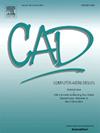Fully discrete subdivision-based IGA scheme with decoupled structure and unconditional energy stability for the phase-field crystal model on surfaces
IF 3.1
3区 计算机科学
Q2 COMPUTER SCIENCE, SOFTWARE ENGINEERING
引用次数: 0
Abstract
In this work, we aim to numerically solve the phase-field crystal (PFC) model to simulate atomic growth on manifolds. The geometric complexity, pronounced curvature variations, and nonlinearities inherent in the physical model pose significant challenges, necessitating the development of efficient and robust numerical schemes that can handle strong coupling and nonlinear terms while accurately accounting for curved geometries. To address these challenges, we first adopt a subdivision-based isogeometric analysis (IGA) for spatial discretization. This approach effectively resolves geometric complexities by offering hierarchical refinability, geometric exactness, and adaptability to arbitrary topologies, while eliminating geometric errors commonly encountered in traditional finite element methods. For temporal discretization, the highly nonlinear terms in the model are addressed using the Invariant Energy Quadratization (IEQ) method, which linearizes the nonlinear terms and guarantees strict unconditional energy stability. However, the introduction of auxiliary variables in the IEQ method results in a linearly coupled system. To overcome this limitation and further enhance computational efficiency, we incorporate the Zero-Energy-Coupling (ZEC) approach, ultimately constructing a scheme that achieves second-order accuracy, linearity, unconditional energy stability, and a fully decoupled structure. We rigorously prove the energy stability and solvability of the proposed scheme and validate its accuracy and robustness through extensive numerical experiments conducted on manifolds, demonstrating its capability to handle intricate geometric structures and nonlinear dynamics effectively.
具有解耦结构和无条件能量稳定的基于完全离散细分的表面相场晶体模型IGA方案
在这项工作中,我们的目标是数值求解相场晶体(PFC)模型来模拟流形上的原子生长。几何复杂性、明显的曲率变化和物理模型固有的非线性构成了重大挑战,需要开发有效且稳健的数值方案,以处理强耦合和非线性项,同时准确地考虑弯曲几何。为了解决这些挑战,我们首先采用基于细分的等高分析(IGA)进行空间离散化。该方法通过提供层次精细化性、几何精确性和对任意拓扑的适应性,有效地解决了几何复杂性,同时消除了传统有限元方法中常见的几何误差。对于时间离散化,采用不变能量二次化(IEQ)方法处理模型中的高度非线性项,该方法将非线性项线性化并保证严格的无条件能量稳定性。然而,在IEQ方法中引入辅助变量会导致线性耦合系统。为了克服这一限制并进一步提高计算效率,我们引入了零能量耦合(ZEC)方法,最终构建了一个实现二阶精度、线性、无条件能量稳定性和完全解耦结构的方案。通过对流形进行的大量数值实验,我们严格地证明了该方案的能量稳定性和可解性,并验证了其准确性和鲁棒性,证明了该方案能够有效地处理复杂的几何结构和非线性动力学。
本文章由计算机程序翻译,如有差异,请以英文原文为准。
求助全文
约1分钟内获得全文
求助全文
来源期刊

Computer-Aided Design
工程技术-计算机:软件工程
CiteScore
5.50
自引率
4.70%
发文量
117
审稿时长
4.2 months
期刊介绍:
Computer-Aided Design is a leading international journal that provides academia and industry with key papers on research and developments in the application of computers to design.
Computer-Aided Design invites papers reporting new research, as well as novel or particularly significant applications, within a wide range of topics, spanning all stages of design process from concept creation to manufacture and beyond.
 求助内容:
求助内容: 应助结果提醒方式:
应助结果提醒方式:


